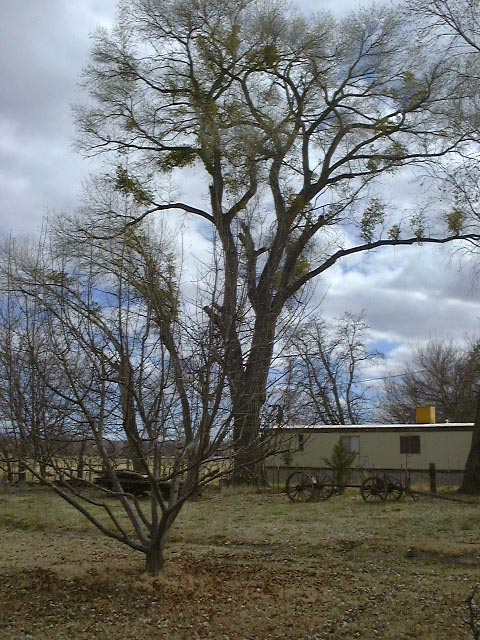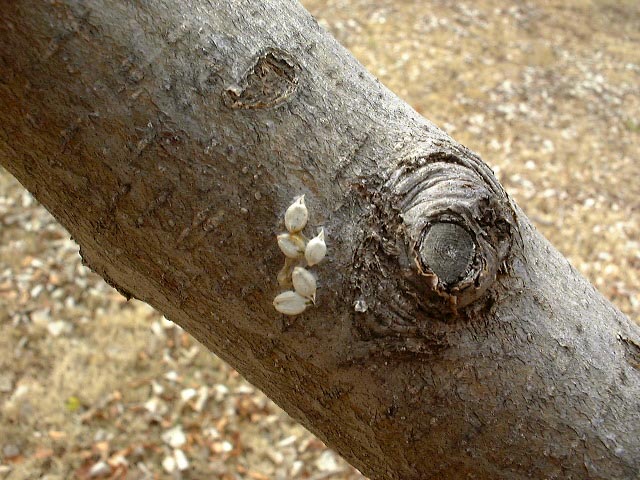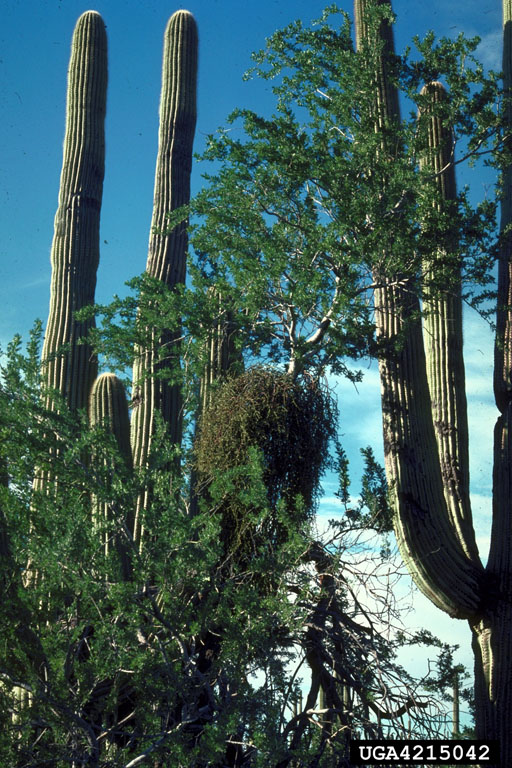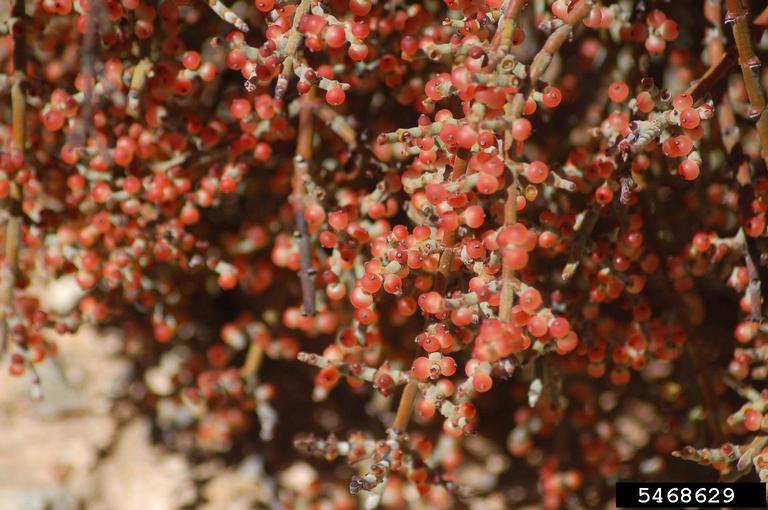 Leafy Mistletoe - May 21, 2014 Jeff Schalau, Agent, Agriculture & Natural Resources University of Arizona Cooperative Extension, Yavapai County Leafy or true mistletoes are known for holiday folklore as well as their parasitic nature, but few people really understand how they colonize woody plants and the effect it has on them. Leafy mistletoes are green plants that utilize another plant, the host, to acquire water and mineral nutrients. Since they are green and photosynthetic, they do produce their own food. While true mistletoes are parasites, they do not readily kill their host and have a few benefits for other species, primarily birds. North American true mistletoes are in the genus Phorodendron and are dioecious: female plants have flowers and produce one-seeded berries while male plants have small inconspicuous flowers that produce pollen. Birds, such as the phainopepla, are reliant on mistletoe berries as a food source. The seeds are covered with a sticky material termed viscin. Once eaten, they pass the seed through their gut yet some of the viscin still adheres to the seed causing it to stick onto limbs of roost trees. After germinating on a suitable host species, the mistletoe’s roots (called haustoria in the phloem and sinkers in the xylem) penetrate the host's bark and grow there. It can take up to two years before mistletoe shoots develop from this “root” system and small shoots emerge from the stem. True mistletoes are not to be confused with dwarf mistletoes. Dwarf mistletoes are not photosynthetic, found only on conifers, and much more damaging to their host plant. In Arizona, we have seven species of leafy or true mistletoe on a variety of trees and shrubs over a range of elevations. In our area, you most commonly see true mistletoe on oaks, cottonwood, willow, junipers, Arizona cypress, mesquite, and hackberry. While it can also be found on box elder, sycamore, or locust, I have not seen it as often on these species. Environmental conditions can affect the establishment and growth rate of true mistletoe. Vigor of true mistletoe plants is usually related to the vigor of the host, and it may decline in otherwise healthy trees during dry periods when host plants are water stressed. On the other hand, heavily infected trees are probably more susceptible to other stresses and insect infections. Seeds of most species require moisture for germination, so infections occur during rainy periods. Leafy mistletoe prevention is not practical because we cannot reliably influence bird behavior. Periodic recruitment of new young trees among older infested trees also allows some mistletoe to remain as part of the landscape. Since the berries of true mistletoes mature in winter, they are an important winter food source for many bird species. Often the areas of greatest mistletoe colonization follow natural drainages where suitable host trees grow and create excellent migratory bird habitat. Some people prune out mistletoe affected limbs or simply prune the mistletoe from the point where it emerges from the host. This does reduce competition between the mistletoe and host and may prevent the mistletoe from flowering and producing more seeds until it regrows. However, it will sprout back if simply removed. When removing affected tree limbs, prune to a crotch at least one foot below the point of emergence and always use proper pruning techniques. On newer infections, this can be very effective. However, on mature infections, you will need to evaluate how the tree might look after this pruning and remember, when pruning trees and shrubs, you should never remove more than 30% of the canopy during one year. With severe infections where the owner is very concerned about an individual plant, I would recommend simply pruning the mistletoe (not tree branches) out if feasible – forget trying to get all the “roots”. It will resprout, but you will have removed some of the stress on the host plant. The plant growth regulator ethephon may also be used as directed by the label to control mistletoe in dormant host trees in winter. As with hand removal, mistletoe will soon regrow at the same point, requiring retreatment. The net effect is similar to pruning it out by hand, but you won’t need to physically climb the tree. I have rare cases where true mistletoe has overcome its host, but usually the host lives for a long time. You will have to decide for yourself, but mostly I tell people not to worry too much about true mistletoe and enjoy the bird watching. Check out the photos and other resources included with the on-line Backyard Gardener (see additional resources below). Follow the Backyard Gardener on Twitter – use the link on the BYG website. If you have other gardening questions, call the Master Gardener help line in the Camp Verde office at 928-554-8999 Ext. 3 or e-mail us at verdevalleymg@gmail.com and be sure to include your name, address and phone number. Find past Backyard Gardener columns or provide feedback at the Backyard Gardener web site: http://cals.arizona.edu/yavapai/anr/hort/byg/. Additional Resources True Mistletoe University of Arizona Cooperative Extension extension.arizona.edu/sites/extension.arizona.edu/files/pubs/az1308.pdf Mistletoes: Pathology, Systematics, Ecology, and Management 2008, Plant Disease 92:7, Bob Mathiasen (NAU), Daniel Nickrent, David Shaw, and David Watson (an excellent article with a broad ecological focus) ferm.forestry.oregonstate.edu/sites/default/files/pdf/ShawMistletoes2008.pdf Not Just for Kissing: Mistletoe and Birds, Bees, and Other Beasts U.S. Geological Survey www.usgs.gov/newsroom/special/mistletoe/      |